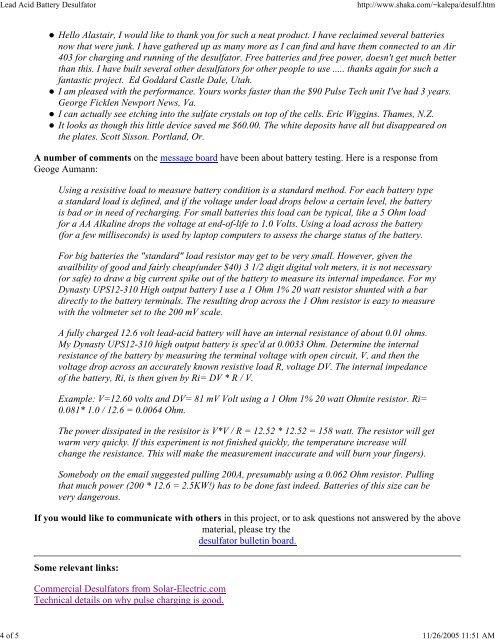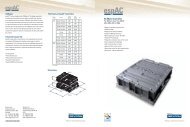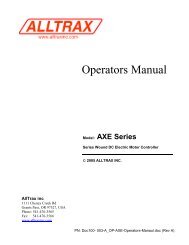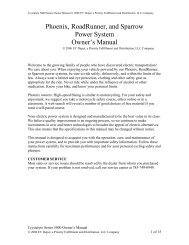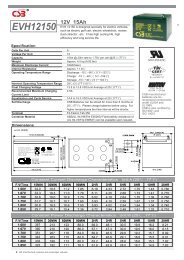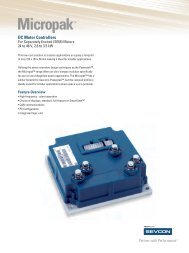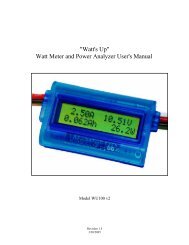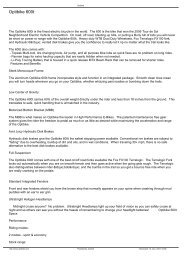Lead Acid Battery Desulfator - V is for Voltage electric vehicle forum
Lead Acid Battery Desulfator - V is for Voltage electric vehicle forum
Lead Acid Battery Desulfator - V is for Voltage electric vehicle forum
Create successful ePaper yourself
Turn your PDF publications into a flip-book with our unique Google optimized e-Paper software.
<strong>Lead</strong> <strong>Acid</strong> <strong>Battery</strong> <strong>Desulfator</strong>http://www.shaka.com/~kalepa/desulf.htm4 of 5 11/26/2005 11:51 AMHello Alastair, I would like to thank you <strong>for</strong> such a neat product. I have reclaimed several batteriesnow that were junk. I have gathered up as many more as I can find and have them connected to an Air403 <strong>for</strong> charging and running of the desulfator. Free batteries and free power, doesn't get much betterthan th<strong>is</strong>. I have built several other desulfators <strong>for</strong> other people to use ..... thanks again <strong>for</strong> such afantastic project. Ed Goddard Castle Dale, Utah.I am pleased with the per<strong>for</strong>mance. Yours works faster than the $90 Pulse Tech unit I've had 3 years.George Ficklen Newport News, Va.I can actually see etching into the sulfate crystals on top of the cells. Eric Wiggins. Thames, N.Z.It looks as though th<strong>is</strong> little device saved me $60.00. The white deposits have all but d<strong>is</strong>appeared onthe plates. Scott S<strong>is</strong>son. Portland, Or.A number of comments on the message board have been about battery testing. Here <strong>is</strong> a response fromGeoge Aumann:Using a res<strong>is</strong>itive load to measure battery condition <strong>is</strong> a standard method. For each battery typea standard load <strong>is</strong> defined, and if the voltage under load drops below a certain level, the battery<strong>is</strong> bad or in need of recharging. For small batteries th<strong>is</strong> load can be typical, like a 5 Ohm load<strong>for</strong> a AA Alkaline drops the voltage at end-of-life to 1.0 Volts. Using a load across the battery(<strong>for</strong> a few mill<strong>is</strong>econds) <strong>is</strong> used by laptop computers to assess the charge status of the battery.For big batteries the "standard" load res<strong>is</strong>tor may get to be very small. However, given theavailbility of good and fairly cheap(under $40) 3 1/2 digit digital volt meters, it <strong>is</strong> not necessary(or safe) to draw a big current spike out of the battery to measure its internal impedance. For myDynasty UPS12-310 High output battery I use a 1 Ohm 1% 20 watt res<strong>is</strong>tor shunted with a bardirectly to the battery terminals. The resulting drop across the 1 Ohm res<strong>is</strong>tor <strong>is</strong> eazy to measurewith the voltmeter set to the 200 mV scale.A fully charged 12.6 volt lead-acid battery will have an internal res<strong>is</strong>tance of about 0.01 ohms.My Dynasty UPS12-310 high output battery <strong>is</strong> spec'd at 0.0033 Ohm. Determine the internalres<strong>is</strong>tance of the battery by measuring the terminal voltage with open circuit, V, and then thevoltage drop across an accurately known res<strong>is</strong>tive load R, voltage DV. The internal impedanceof the battery, Ri, <strong>is</strong> then given by Ri= DV * R / V.Example: V=12.60 volts and DV= 81 mV Volt using a 1 Ohm 1% 20 watt Ohmite res<strong>is</strong>tor. Ri=0.081* 1.0 / 12.6 = 0.0064 Ohm.The power d<strong>is</strong>sipated in the res<strong>is</strong>itor <strong>is</strong> V*V / R = 12.52 * 12.52 = 158 watt. The res<strong>is</strong>tor will getwarm very quicky. If th<strong>is</strong> experiment <strong>is</strong> not fin<strong>is</strong>hed quickly, the temperature increase willchange the res<strong>is</strong>tance. Th<strong>is</strong> will make the measurement inaccurate and will burn your fingers).Somebody on the email suggested pulling 200A, presumably using a 0.062 Ohm res<strong>is</strong>tor. Pullingthat much power (200 * 12.6 = 2.5KW!) has to be done fast indeed. Batteries of th<strong>is</strong> size can bevery dangerous.If you would like to communicate with others in th<strong>is</strong> project, or to ask questions not answered by the abovematerial, please try thedesulfator bulletin board.Some relevant links:Commercial <strong>Desulfator</strong>s from Solar-Electric.comTechnical details on why pulse charging <strong>is</strong> good.


